
UNUSUAL LAVA TYPES
STRONGLY
ALKALINE LAVAS
One way to classify
lavas is by their alkali content, reflected in their weight percent
of Na2O + K2O. In contrast to the common lava types (basalt, andesite, dacite, and rhyolite), there exists less common
lavas that define mildly alkaline trends (e.g.,
with increasing silica content: alkali basalt, trachybasalt, trachyandesite,
trachyte, and comendite), and strongly alkaline
trends (e.g., with increasing silica content: tephrite, phonotephrite,
tephriphonolite, and phonolite). Although
these lavas can occur in a variety of tectonic settings, they
are typically found in either (1) continental or oceanic intraplate
settings, where there is often a lack of significant tectonic
control, (2) continental rift zones, and (3) the back-arc setting
of subduction zones.
|
|
|
Alkali-rich phonolite lavas extruding
from basaltic scoria cones on the Harrat Kishb lava field, western
Saudi Arabia. Note -- Phonolite lavas derive their name
from the high-pitched bell-tone created when striking the lava
with a hammer. |
|
Alkali-rich lavas are often charateristic
of the waning stages of volcanism, as demonstrated, for example,
in the late-stage parasitic
cones and flows found on Hawaiian shield volcanoes. Differentiated
trachytic and phonolitic lavas typically erupt as low-volume flows
with high aspect ratios,
as demonstrated above in the phonolite coulées
of western Saudi Arabia. However, extensive sheetflows of
similar lavas have been recognized in continental rift zones,
as exemplified in the voluminous phonolitic lavas of the Ethiopian
rift system.
CARBONATITES
Carbonatites are perhaps the most
unusual of all lavas. They are defined, when crystalline, by having
more than 50% carbonate (CO3-bearing) minerals, and typically they
are composed of less than 10% SiO2. There are only 330 known carbonatite
localities on Earth, most of which are shallow intrusive bodies
of calcite-rich igneous rock in the form of volcanic necks, dikes,
and cone-sheets. These generally occur in association with larger
intrusions of alkali-rich silicate igneous rocks. Extrusive carbonatites
are particularly rare, and appear to be restricted to a few continental
rift zones, such as the Rhine valley and the East African rift
system.
Most
carbonatite lavas have low eruption temperatures, between 500
and 600 degrees Centigrade (compared with >1100 degrees Centigrate
for basaltic lavas). They typically have low viscosities due to
their lack of silica polymerization. Thus, carbonatite flows are
generally only a few centimeters thick, with surface textures
that vary from a'a
to pahoehoe.
Although they often resemble flowing lobes of black mud, they
are hot enough to display glowing, deep-red colors when seen at
night. Some active carbonatite flows are enriched in alkalies
(Na and K) - these are called natrocarbonatites. Soon after
their eruption, dark natrocarbonatite flows will cool and rapidly
turn white due to reaction with atmospheric water.
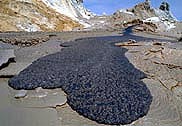 |
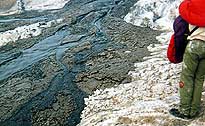 |
|
A 5-cm thick carbonite a'a flow
advancing from lava lake. Courtesy of Marco Fulle - http://stromboli.net |
|
|
Pahoehoe carbonite flow bounded
by blocky lava levee. Note older lava, turned white by hydration.
Courtesy of Celia Nyamweru. |
|
OLDOINYO LENGAI, TANZANIA
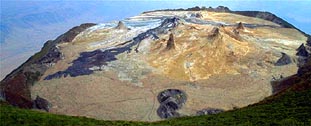 The East African Rift
System contains a vast array of igneous rocks, dominated by voluminous
floods of basaltic lava. Its highest peaks, Mt. Kilamanjoro and
Mt. Kenya, are active volcanoes located along the eastern rift
of Lake Victoria. Lying between these impressive peaks is the
only know active carbonatite volcano in the world - Oldoinyo
Lengai. Rising over 2200 meters from the valley floor, the
bulk of this volcanic cone is composed phonolitic tephra. However,
its upper portion is dominated by natrocarbonatite lava
flows. Historic eruptions of natrocarbonatite have filled much
of the summit crater, shown here courtesy of Marco Fulle -
stromboli.net. Note the tall conical hornitos protruding from the crater
floor.
The East African Rift
System contains a vast array of igneous rocks, dominated by voluminous
floods of basaltic lava. Its highest peaks, Mt. Kilamanjoro and
Mt. Kenya, are active volcanoes located along the eastern rift
of Lake Victoria. Lying between these impressive peaks is the
only know active carbonatite volcano in the world - Oldoinyo
Lengai. Rising over 2200 meters from the valley floor, the
bulk of this volcanic cone is composed phonolitic tephra. However,
its upper portion is dominated by natrocarbonatite lava
flows. Historic eruptions of natrocarbonatite have filled much
of the summit crater, shown here courtesy of Marco Fulle -
stromboli.net. Note the tall conical hornitos protruding from the crater
floor.
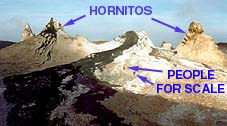 |
Many of these
hornitos are quite large, as demonstrated in the image left (Courtesy
of Burra Gadiye). The dark natrocarbonatite flows shown here
erupted in 1998. Continued ativity from on Oldoinyo Lengai from
1995 to 2001 is demonstrated in the following images of erupting
hornitos. |
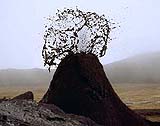 |
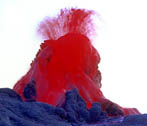 |
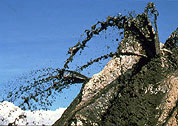 |
|
December 1995 - Spectacular bubbling of natrocarbonatite
spatter from a small hornito on Oldoinyo Lengai. Courtesy
of Peirre Vetsch |
|
|
July 2001 - With very low light, carbonatite lavas
can display reddish colors, as shown in this erupting hornito.
Courtesy of Marco Fulle - http://stromboli.net |
|
|
March 1999 - Squirting of natrocarbonatite spatter
from openings in the wall of a hornito on Oldoinyo Lengai. Courtesy
of Frank Pothe. |
|
ORIGIN OF CARBONATITE
A history of controversy
has surrouned the origin of carbonatites, and whether or not calcite
carbonatites are primary or secondary lavas. Some scientists believe
that the Ca-carbonatites are generated by fractional melting of
crustal carbonate rocks. However, others believe that the Ca-carbonatites
are not primary magmas at all, but rather derived from the alteration
of Na-rich natrocarbonatite lavas. Virtually, all natrocarbonatites
on Earth are found in historic eruptions, and none in ancient
rocks. Many have attributed this to the very high solubility of
sodium carbonate. The argument being that all carbonatites were
originally natrocarbonatites that have had sodium removed by hydrothermal
solutions and rainwater.
The natrocarbonatites
themselves appear to have clear isotopic signatures indicating
their origin from a mantle source. The very high Na2O and very low MgO compositions of the
Oldoinyo Lengai natrocarbonatites suggest that they are highly
differentiated magmas. The common association of carbonatites
with alkali-rich silicate rocks (e.g., nephelinite) suggests further
that liquid immiscibility between silicate and carbonate magmas
may have played a role in their origin.
KOMATIITES
Named from their type locality
along the Komati River in South Africa, komatiites are ultramafic
volcanic rocks, having very low silica
contents (~40-45%) and very high MgO contents (~18%). These lavas
are exceptional not only for their compositions, but also for
their very old, restricted ages. These lavas have no modern analogs.
The youngest komatiites (from Gorgona Island, Columbia) have been
dated at about 90 million years; however, all other komatiites
are about three billion years old or older. These ancient lava
flows erupted at a time when the Earth's
internal heat was much greater than today, thus generating
exceptionally hot, fluid lavas with calculated eruption temperatures
in excess of 1,600 degrees C (2,900 degrees F). In comparison,
typical basaltic lavas erupting today have eruption temperatures
of about 1,100 degrees C.
A spectauclar identifying trait
of komatiites is their spinifex texture, which resembles
a lacey mesh of acicular (needle-like) olivine crystals, typically
surrounded by lighter-colored, interstitial minerals such as plagioclase,
tremolite, and/or chlorite. The elongated nature of the komatiite
olivine crystals is quite distinct when compared with the equant
to tabular olivine crystals seen in most basaltic rocks.
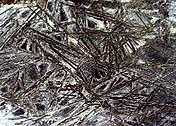 |
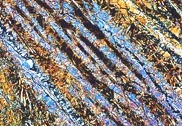 |
|
Thin section of spinifex texture
from a komatiite sampled from the Kaapvaal region of South Africa.
Courtesy of Tim Grove. |
|
|
Spinifex texture under cross-polarized
light. Note acicular olivine crystals with third-order blue interference
colors. Courtesy of Allen Glazner. |
|
Since we have never observed a
komatiite eruption, we have had to deduce the fluid flow character
and eruption style of these lavas from the properties and textures
of the ancient rocks. Their high eruption temperatures, for example,
are calculated from their olivine-rich compositions. The charateristic
spinifex textures on the otherhand, indicate that these lavas
cooled very rapidly. Combined, the high eruption temperatures
and the low silica contents indicate that komatiites erupted as
very fluid lavas, having exceptionally low viscosities
and low aspect ratios.
It is believed that these hot, fluid lavas would have been turbulent,
and therefore capable of a significant amount of both mechanical
and thermal erosion. Indeed, many scientists believe that the
sinuous rilles exposed
on the moon's surface are erosive valleys produced by komatiite
lava flows, contemporaneous with the ancient eruption of similar
lavas on Earth.




 The East African Rift
System contains a vast array of igneous rocks, dominated by voluminous
floods of basaltic lava. Its highest peaks, Mt. Kilamanjoro and
Mt. Kenya, are active volcanoes located along the eastern rift
of Lake Victoria. Lying between these impressive peaks is the
only know active carbonatite volcano in the world - Oldoinyo
Lengai. Rising over 2200 meters from the valley floor, the
bulk of this volcanic cone is composed phonolitic tephra. However,
its upper portion is dominated by natrocarbonatite lava
flows. Historic eruptions of natrocarbonatite have filled much
of the summit crater, shown here courtesy of Marco Fulle -
stromboli.net. Note the tall conical hornitos protruding from the crater
floor.
The East African Rift
System contains a vast array of igneous rocks, dominated by voluminous
floods of basaltic lava. Its highest peaks, Mt. Kilamanjoro and
Mt. Kenya, are active volcanoes located along the eastern rift
of Lake Victoria. Lying between these impressive peaks is the
only know active carbonatite volcano in the world - Oldoinyo
Lengai. Rising over 2200 meters from the valley floor, the
bulk of this volcanic cone is composed phonolitic tephra. However,
its upper portion is dominated by natrocarbonatite lava
flows. Historic eruptions of natrocarbonatite have filled much
of the summit crater, shown here courtesy of Marco Fulle -
stromboli.net. Note the tall conical hornitos protruding from the crater
floor.




